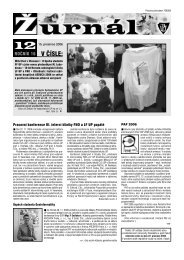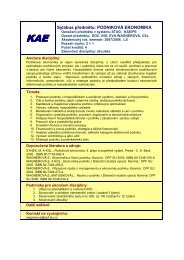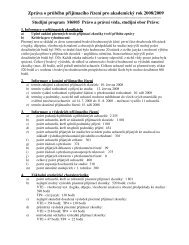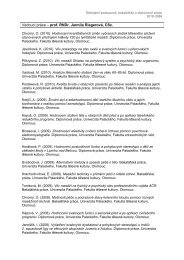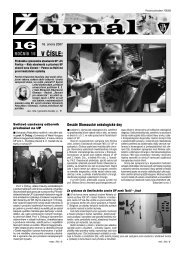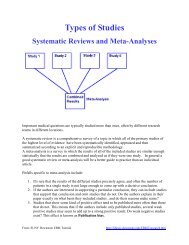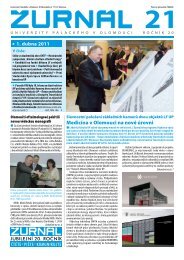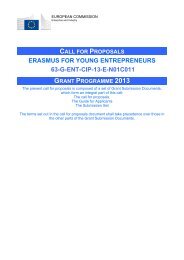ACTA UNIVERSITATIS PALACKIANAE OLOMUCENSIS GYMNICA ...
ACTA UNIVERSITATIS PALACKIANAE OLOMUCENSIS GYMNICA ...
ACTA UNIVERSITATIS PALACKIANAE OLOMUCENSIS GYMNICA ...
- No tags were found...
You also want an ePaper? Increase the reach of your titles
YUMPU automatically turns print PDFs into web optimized ePapers that Google loves.
10 Acta Univ. Palacki. Olomuc., Gymn. 2004, vol. 34, no. 2TABLE 3Burnout of physical training teachers – the statistical analysis of dimensions from the Maslach Burnout Inventory(MBI) within particular clusters (emotional exhaustion EE, negative sense of professional achievement NSPA, depersonalizationDP)MBI I. II.ClusterIII. IV. V. Totalx– SD – x SD – x SD – x SD – x SD – x SDEE 8.9 5.39 53.0 – 8.2 3.81 21.5 2.17 21.7 6.68 12.7 8.45NSPA 6.8 4.29 34.0 – 18.7 5.41 10.7 5.82 16.6 6.54 11.0 7.34DP 2.9 2.97 18.0 – 3.7 2.81 12.2 5.04 5.9 4.30 4.1 3.93TABLE 4Cluster description: gender, age and duration of employment among physical training teachersClusterFemalesGender Age Duration ofemploymentMalesN % N % x – SD x – SDI. 79 52.7 71 47.3 36.2 2.97 12.4 8.10II. 0 0 1 100 50.0 – 25.0 –III. 16 53.5 14 46.7 38.8 8.54 14.2 8.46IV. 4 66.7 2 33.3 33.0 7.18 7.3 4.84V. 45 65.2 24 34.8 37.5 7.82 12.9 7.50Total 144 100 112 100 36.9 7.86 12.7 7.97Subsequent statistical analyses allowed for definingfive clusters in the studied population (TABLE 2). Theclusters were homogenous with respect to burnout leveland they grouped individuals characterized by the sameburnout pattern, i.e. with similar values of the three dimensions:emotional exhaustion (EE), negative sense ofprofessional achievement (NSPA) and depersonalization(DP) (TABLE 3–4). In view of the fact that the burnoutprocess in female (N = 144) and male physical trainingteachers (N = 112) was similar (ANOVA, F = 0.881,p > 0.05), the variable of gender was disregarded infurther analyses.Among the respondents, 58.6% were found not tobe burned out (Cluster I; N = 150) (TABLE 2–3, Fig.1). Working with children was a clear source of satisfactionto this group of educators – their mean value ofthe negative sense of professional achievement dimension(x – I. NSPA = 6.8) was almost twice as low as themean value for the entire population (x – NSPA = 11.0).Characterized by a relatively low degree of burnout,these teachers were capable of maintaining the closestcontacts with their pupils – the mean value of the depersonalizationdimension DP (x – I. DP = 2.9) was thelowest in this cluster (TABLE 3).Clusters II and V (N = 70) grouped burned-outteachers (27.4%), who experienced symptoms of emotionalexhaustion and depersonalization, while clearlyderiving no satisfaction from their work. In the remainingteachers – Cluster III and IV (N = 36; 14.0%) theburnout syndrome was beginning to manifest itself indiverse ways (TABLE 2–3).Cluster II was a one-element cluster (TABLE2–4). Very high values of the three MBI dimensions:EE = 53.0, NSPA = 34.0 and DP = 18.0, proved a veryhigh, outright extreme burnout level in one respondent,a male teacher of a junior high school employed for 25years (Fig. 2).The population of physical education teachersgrouped in Cluster V was also characterized by highmean values of the triad of factors that together formedthe phenomenon of burnout. Considerable emotionalexhaustion was clearly seen (x – V.EE = 21.7) (TABLE 3).




